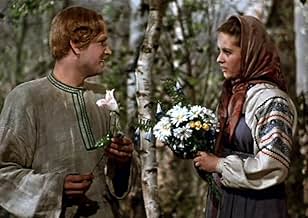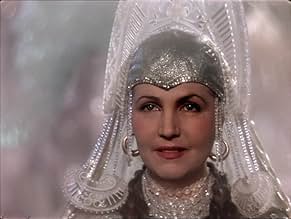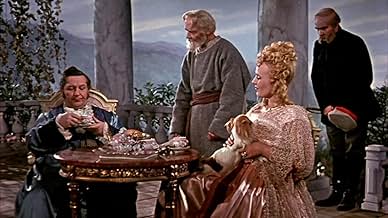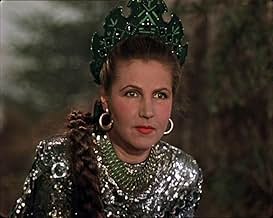Obcecado em aperfeiçoar seu ofício, um escultor de pedras preciosas visita a Montanha de Cobre para descobrir o segredo por trás de sua atração: a Flor de Pedra, uma escultura de pedra tão c... Ler tudoObcecado em aperfeiçoar seu ofício, um escultor de pedras preciosas visita a Montanha de Cobre para descobrir o segredo por trás de sua atração: a Flor de Pedra, uma escultura de pedra tão cativante que ninguém pode sair depois de vê-la.Obcecado em aperfeiçoar seu ofício, um escultor de pedras preciosas visita a Montanha de Cobre para descobrir o segredo por trás de sua atração: a Flor de Pedra, uma escultura de pedra tão cativante que ninguém pode sair depois de vê-la.
- Direção
- Roteiristas
- Artistas
- Prêmios
- 2 vitórias e 2 indicações no total
Vladimir Druzhnikov
- Danilo - master
- (as V. Druzhnikov)
Yekaterina Derevshchikova
- Katya
- (as Y. Derevshchikova)
Mikhail Troyanovskiy
- Prokopych
- (as M. Troyanovsky)
Mikhail Yanshin
- Severyan
- (as M. Yanshin)
Nikolay Temyakov
- Barin
- (as N. Temyakov)
Anna Petukhova
- Barina
- (as A. Petukhova)
Nikolai Orlov
- Stary master
- (as N. Orlov)
Lidiya Deikun
- Vikhorika
- (as L. Deikun)
Serafim Zaytsev
- Yefimka
- (as S. Zaytsev)
Vitaliy Kravchenko
- Danilo - malchyk
- (as V. Kravchenko)
- Direção
- Roteiristas
- Elenco e equipe completos
- Produção, bilheteria e muito mais no IMDbPro
Avaliações em destaque
So says the grizzled old factory watchman at the conclusion of the folk tale he's been telling the children huddled around his fire through the Russian night. One of the young boys comes quietly up to him as the others leave, and tells him that he too wants to be a master-stoneworker, like the hero of the story: "ah!", says the watchman, "you got the point!" And the point's not just for children, either.
Ptushko's memorably beautiful film makes for a gripping parable about the conflict between the inner and outer life of the born artist, willing to risk sacrificing everything - even the woman he loves - in pursuit of artistic and technical perfection. At the secret heart of the Copper Witch's caverns, the Stone Flower itself represents that unattainable ideal of beauty, natural material fashioned so cunningly that it seems more real than reality itself. Danila, deeply unsatisfied with his work admired though it is by so many, has to study its form at any price, leaving his betrothal feast to pursue his ideal and hone his technique.
Will Danila break free of the Copper Witch's charms, and return to the "real world"? You'll have to watch the film to find out...
With only four significant characters - the young genius, the ageing and ailing master-craftsman who teaches (or is taught by) him, his faithful betrothed Katinka, and of course the Copper Witch herself - "Kamennyy tsvetok" is much more tightly structured and less riotously inventive than some of the other Ptuchko films I've been privileged to see, and the tension never flags.
Political content, too, is restrained - surprisingly so, given the film's date and the fact that it was (as other commentators have pointed out) the first major Russian film to be made in colour. The peasants are duly repressed by the fat and frivolous landowners and their brutal class-traitor henchmen, but (assuming that *my* brain has figured it out correctly!) the clear message is that whatever its conflicts with everyday life and relationships, art certainly transcends politics and class. Surprising indeed. There's even a moment in the beautifully depicted and choreographed folk betrothal where religious icons are bowed to with grace and reverence. It is amazing that Ptushko was daring enough to try to get that one past the censors, let alone manage to succeed!
The commentator who compared the visual feast on offer with Powell and Pressburger's roughly contemporary "The Red Shoes" was spot on: their "Tales of Hoffmann" is even closer in spirit. Ptushko's visual imagination and daring are in that league, and his colour process produced really breathtaking pictures. If his images here seem more illustrative and pictorial, less intrinsically filmic than the art of those English masters, they are none the less memorable. The magic scenes in the woods, and in the gem-sparkling caverns, are of a loveliness seldom matched in film of any era, and never surpassed.
The currently available RUSCICO DVD version is quite beautifully restored visually, and the sound is very acceptable too. With good extras, including a half-hour feature about Ptushko's life and work showcasing extracts from many of his other films, why not treat yourself and your family, if you have one, to this rich folk-tale? If you respond to it as I did, you may even manage - for one brief, shining moment - to feel that you are nine years old once again!
Ptushko's memorably beautiful film makes for a gripping parable about the conflict between the inner and outer life of the born artist, willing to risk sacrificing everything - even the woman he loves - in pursuit of artistic and technical perfection. At the secret heart of the Copper Witch's caverns, the Stone Flower itself represents that unattainable ideal of beauty, natural material fashioned so cunningly that it seems more real than reality itself. Danila, deeply unsatisfied with his work admired though it is by so many, has to study its form at any price, leaving his betrothal feast to pursue his ideal and hone his technique.
Will Danila break free of the Copper Witch's charms, and return to the "real world"? You'll have to watch the film to find out...
With only four significant characters - the young genius, the ageing and ailing master-craftsman who teaches (or is taught by) him, his faithful betrothed Katinka, and of course the Copper Witch herself - "Kamennyy tsvetok" is much more tightly structured and less riotously inventive than some of the other Ptuchko films I've been privileged to see, and the tension never flags.
Political content, too, is restrained - surprisingly so, given the film's date and the fact that it was (as other commentators have pointed out) the first major Russian film to be made in colour. The peasants are duly repressed by the fat and frivolous landowners and their brutal class-traitor henchmen, but (assuming that *my* brain has figured it out correctly!) the clear message is that whatever its conflicts with everyday life and relationships, art certainly transcends politics and class. Surprising indeed. There's even a moment in the beautifully depicted and choreographed folk betrothal where religious icons are bowed to with grace and reverence. It is amazing that Ptushko was daring enough to try to get that one past the censors, let alone manage to succeed!
The commentator who compared the visual feast on offer with Powell and Pressburger's roughly contemporary "The Red Shoes" was spot on: their "Tales of Hoffmann" is even closer in spirit. Ptushko's visual imagination and daring are in that league, and his colour process produced really breathtaking pictures. If his images here seem more illustrative and pictorial, less intrinsically filmic than the art of those English masters, they are none the less memorable. The magic scenes in the woods, and in the gem-sparkling caverns, are of a loveliness seldom matched in film of any era, and never surpassed.
The currently available RUSCICO DVD version is quite beautifully restored visually, and the sound is very acceptable too. With good extras, including a half-hour feature about Ptushko's life and work showcasing extracts from many of his other films, why not treat yourself and your family, if you have one, to this rich folk-tale? If you respond to it as I did, you may even manage - for one brief, shining moment - to feel that you are nine years old once again!
The art direction and production design in the movie is really quite fetching. The physical film that was accordingly used to shoot 'The stone flower' resulted in rich, vibrant colors that allow every little trait to pop out brilliantly. Wonderful attention to hair, makeup, costume design, and set design and decoration, and every nuance of the cast's performances, is realized with inspiring vividness. Moreover, director Aleksandr Ptushko demonstrates a keen eye for arranging some fine shots, solid camerawork, and good care for lighting. And these are only just the visual aspects of what is an engaging, charming interpretation of a folk tale.
All the assembled actors put on fine displays of their skills to bring the picture to life, with Vladimir Druzhnikov especially notable as protagonist Danilo - believably portraying the young man's resolve, and obsession. Yet to discuss such facets at greater length seems unimportant when above all they serve simply as a component of the whole. It's the writing and direction that makes 'The stone flower' the entertaining classic that it is. Characters generally aren't written with especial depth, but like the acting, they work to complete the tableau. So it is too with the dialogue, very much feeling like the living communication of the sort of story that would be passed down over years - in no few ways a fable about the folly of pride, and ambition. And with that said, the fantastical scene writing and overall narrative are the greatest treasures here: terrifically entrancing, flush with detail and careful consideration, and enriching the entirety of the feature in their excellence. Druzhnikov matches the grand screenplay with adept focus and dexterity, tying the picture together with marvelous, expert finesse.
Factor in winsome set pieces, modest but suitable special effects - on par with any of the era - and gratifying instances of deftly arranged song and dance, and 'The stone flower' quite feels like it could be an early live-action production of Walt Disney's imagination. It's superb in its craft, and pleasantly endearing - really just an all-around lovely slice of cinema. If I have any specific criticism to make, it may perhaps be that the pacing struggles early on to find its footing. Yet for as splendidly well as the film is made, what slight deficiencies do crop up are negligible, and not truly significant. This is a magically, quietly engrossing movie, appropriate for all ages, that I think is surely very enjoyable for any viewer receptive to the type of story that it relates. I'd have no qualms recommending this to just about anyone - 'The stone flower' is a lot more fun, satisfying, and even rewarding than I thought it was going to be, and this is well worth checking out if you have the opportunity!
All the assembled actors put on fine displays of their skills to bring the picture to life, with Vladimir Druzhnikov especially notable as protagonist Danilo - believably portraying the young man's resolve, and obsession. Yet to discuss such facets at greater length seems unimportant when above all they serve simply as a component of the whole. It's the writing and direction that makes 'The stone flower' the entertaining classic that it is. Characters generally aren't written with especial depth, but like the acting, they work to complete the tableau. So it is too with the dialogue, very much feeling like the living communication of the sort of story that would be passed down over years - in no few ways a fable about the folly of pride, and ambition. And with that said, the fantastical scene writing and overall narrative are the greatest treasures here: terrifically entrancing, flush with detail and careful consideration, and enriching the entirety of the feature in their excellence. Druzhnikov matches the grand screenplay with adept focus and dexterity, tying the picture together with marvelous, expert finesse.
Factor in winsome set pieces, modest but suitable special effects - on par with any of the era - and gratifying instances of deftly arranged song and dance, and 'The stone flower' quite feels like it could be an early live-action production of Walt Disney's imagination. It's superb in its craft, and pleasantly endearing - really just an all-around lovely slice of cinema. If I have any specific criticism to make, it may perhaps be that the pacing struggles early on to find its footing. Yet for as splendidly well as the film is made, what slight deficiencies do crop up are negligible, and not truly significant. This is a magically, quietly engrossing movie, appropriate for all ages, that I think is surely very enjoyable for any viewer receptive to the type of story that it relates. I'd have no qualms recommending this to just about anyone - 'The stone flower' is a lot more fun, satisfying, and even rewarding than I thought it was going to be, and this is well worth checking out if you have the opportunity!
For the commentator below, I thought I had seen it on tape but I'm not sure. Most probably saw it an art house in Chicago or some university festival (Roosevelt University had a very good one back then).
The film's use of color was a landmark breakthrough. It was a process different and superior to technicolor. We can do it today in say, Kodacolor, and "The Red Shoes" did indeed quite approximate it but good as that was, it did not equal SF,
I wonder if Martin Scorcese, who did a commentary for "The Red Shoe" saw it. I'm sure he would have been impressed and if someone could get to him today he might even promote putting it on DVD just for gras artis gras.
The film was of some importance politically too in that it was the first kind of cultural exchange gesture the Soviets made at the height of the cold war. We probably sent them "Gone With The Wind." I mean that.
The film's use of color was a landmark breakthrough. It was a process different and superior to technicolor. We can do it today in say, Kodacolor, and "The Red Shoes" did indeed quite approximate it but good as that was, it did not equal SF,
I wonder if Martin Scorcese, who did a commentary for "The Red Shoe" saw it. I'm sure he would have been impressed and if someone could get to him today he might even promote putting it on DVD just for gras artis gras.
The film was of some importance politically too in that it was the first kind of cultural exchange gesture the Soviets made at the height of the cold war. We probably sent them "Gone With The Wind." I mean that.
The Stone Flower as a piece of cinematic art, seems to surpass Disney, or The Wizard of Oz, in a similar visual vein, and always clearly presents it's own unique impeccable, and intricate attention to delicate detail, not found in many other films.
There is a pleasing sense of welcoming and invitingness to the film, and with kindness and gladness it opens itself up to you to come along and enjoy.
Great care, classiness, and refinement abound in the production of The Stone Flower, and it makes for a beautiful experience to watch. And whether you can understand Russian, or not, visually the story will keep it's pace, and lead the way for you quite clearly.
The Stone Flower is a tale of folk, and a tale of beautifulness and happiness, and it is sprinkled in the icing sugar of magicalness, and fantasy!
A very lovely film! :)
There is a pleasing sense of welcoming and invitingness to the film, and with kindness and gladness it opens itself up to you to come along and enjoy.
Great care, classiness, and refinement abound in the production of The Stone Flower, and it makes for a beautiful experience to watch. And whether you can understand Russian, or not, visually the story will keep it's pace, and lead the way for you quite clearly.
The Stone Flower is a tale of folk, and a tale of beautifulness and happiness, and it is sprinkled in the icing sugar of magicalness, and fantasy!
A very lovely film! :)
Seen shortly after it was released. A beautiful, and apparently rare film, since I have never seen a video of it available. Easily equal to the work of Serge Eisenstein, produced during the Stalinist days of the USSR, but is a telling of a famous Russian fable. An excellent film, which should be on video.
Você sabia?
- ConexõesFeatured in Good Bye, Sowjetunion! (2021)
Principais escolhas
Faça login para avaliar e ver a lista de recomendações personalizadas
Detalhes
- Tempo de duração1 hora 29 minutos
- Mixagem de som
- Proporção
- 1.37 : 1
Contribua para esta página
Sugerir uma alteração ou adicionar conteúdo ausente

Principal brecha
By what name was Flor de Pedra (1946) officially released in Canada in English?
Responda
























